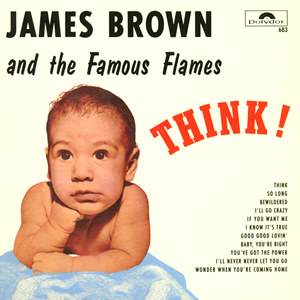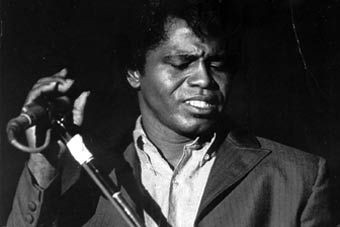The word "LIVE!", shouting from the covers of so many of his albums, seems inseparable from the soul and essence of James Brown. That -- and the boundless energy he showed onstage throughout a 50 year career, not to mention the boundless invention he showed in the recording studio over an equal period of time -- make the news of his death on Christmas morning hard to accept.
Back in the 1970s, when punk was starting to happen, I was in a record store and the seller, who knew my tastes, steered me gently but firmly in the direction of the newly reissued LIVE AT THE APOLLO, VOLUME 1 by James Brown. I was a little hesitant because it was an earlier era of music than I tended to buy, and I was mostly listening to trancey avant garde alternative rock; also, the cover art was kind of kitschy, an airbrushed rendering of JB in a vast pompadour howling into a stage microphone. But I bought it and, lo and behold, it was one of the great musical discoveries of my life. I loved it.
I loved it enough to scoop up a used copy of JB's 1974 double album HELL as soon as I found one; it was recorded in a different era than the APOLLO disc, but it was, if anything, even more feisty and infectious. I especially loved the closing, side-long track "Papa Don't Take No Mess," which has the crackly sound of a groove-sampling epic decades before there were such things. It was around this same time that Robert Christgau devoted an installment of his "Consumer Guide" in CREEM magazine to JB, reviewing and grading all of his 1970s-80s work. I think I would have graded HELL a fraction better than he did, which gave me my bearings and stoked my curiosity. Then, just as I was starting to wonder how some things like "Soul Power" and "Get On The Good Foot" sounded, an Australian import appeared -- the first double-album Greatest Hits collection ever devoted to the full breadth of JB's work. Once I heard "Give It Up or Turnit A Loose" and "Sex Machine," there was no turning back. I had to collect the whole story, hear every track, leave no groove unturned. Again, as if by divine coincidence, GOLDMINE chose that precise moment to devote a feature article to James Brown, equipped with a complete discography -- my road map.
Mr. Brown's first record label, King Records, was Cincinnati-based, which made my quest a bit easier to accomplish, but over the course of the following 8-10 years, I subsequently found and bought every legitimately released JB album on vinyl, and then on CD. We're talking more than 100 albums, plus variants, repackagings, and special releases.
Little Richard calls himself "the architect of rock and roll," but James Brown made an epithet like that seem like so many small potatoes. JB was the architect of everything that came after rock and roll: soul, disco, rap, extended grooves and improvs, drum and bass, trance, sampling (he remains the most-sampled artist ever, possibly for "Funky Drummer" alone), and whatever comes next, probably. He was the first R&B artist to venture outside the box of 4/4 R&B shuffles. His rhythms and increasingly complex polyrhythms struck a mathematical counterpoint to the directness and simplicity of his message, which could be pro-social and constructive ("Say It Loud, I'm Black and I'm Proud," "Get Up, Get Into It, Get Involved!"), narcissistic ("I paid the cost to be the Boss"), or nakedly rut-hungry ("Can I get INTO it? Can I get INTO it? Can I pull the sheet off of 'em? CAN I GET INTO IT?"). Because the music cut deeper and deeper with each repetition of the groove, no music was ever sexier or more sensual.
I've heard everything he ever recorded, and it must be admitted that he recorded his fair share of material that was dumb or preachy (the very last track on his last album was called "Killing's Out, School Is In") or in questionable taste; and, if truth be told, his live shows have been half-spirited and often tacky since his 1991 release from prison -- but none of that matters in terms of the Big Picture. He was also a visionary artist, a dazzling showman, and he could be very, very funny. (Check out "For Goodness Sakes, Take A Look At Those Cakes," an epic paen to butt-watching in which he actually invites Stevie Wonder and Ray Charles to "lookie here" and "lookie there," or the great moment in "Make It Funky" when Bobby Byrd pathetically beseeches JB to NOT be so funky, and he fires back "I cain't hep it, Byrd.") He was way too prolific to be perfect (someone once said that, if JB sneezed in the studio, he'd release it as a two-sided single), and if his last fifteen years of live performance were not his best, the show with which he toured represented a lot of mouths he had to feed, and he remained James Brown and all that JB represented till the end. Despite that, the quality of his releases always remained respectable (his penultimate album I'M BACK is very good) and his archival releases (especially the unparalleled box set STAR TIME) were among the best on the market.
I don't think any other one person could be said to have changed (hell, revolutionized) the world of music and the art of live performance to the extent that James Brown did. Mick Jagger didn't dance onstage until he stood in the wings and watched JB dance his way through his T.A.M.I. SHOW performance in 1964, a performance the Stones had to follow, which remains one of the very greatest live pop music performances ever captured on film. In 1986, he was one of the first inductees into the Rock & Roll Hall of Fame, along with Elvis Presley, Chuck Berry, Ray Charles, Little Richard and many other fathers of the form; he was the only inductee that year to simultaneously have a new single zooming up the charts (ROCKY IV's "Living In America").
James Brown may be dead, but I guarantee you he's not resting in peace. Somewhere, he's dancing with the renewed energy of a newborn and already scoping out the thangs ain't never been done.
"What I was doin' thirty years ago is what the rest of 'em are doin'... tomorrow." -- JB MY FAVORITE JAMES BROWN ALBUMS
MY FAVORITE JAMES BROWN ALBUMS
You could do a Top 10 of Best Ofs with JB, but I'm not going to cheat you like that. It should go without saying that nascent JB collectors need the STAR TIME box set first and above all, followed by ROOTS OF A REVOLUTION, FOUNDATIONS OF FUNK, FUNK POWER 1970, MAKE IT FUNKY - THE BIG PAYBACK, and DEAD ON THE HEAVY FUNK -- all fabulous archival overviews of specific periods in Mr. Brown's 50 year career. You can live content with the knowledge that you know your James Brown if you have only those, or some of those. THE GREATEST HITS OF THE FOURTH DECADE collects some worthwhile cuts not included elsewhere. For this list, however, I wanted to focus on JB's individual albums. I consider everything listed below a stand-alone album; though IN THE JUNGLE GROOVE and MOTHERLODE look like hits compilations, they are actually compilations of archival tracks previously unreleased, or in previously unreleased form. Albums are listed in my personal order of preference. Can't do a Top 10, but this isn't a Top 10, so I don't have to.
1. IN THE JUNGLE GROOVE 2. LIVE AT THE APOLLO, VOL. 1 3. LIVE AT THE APOLLO, VOL. 2 (original version; Side Two's suite of "Let Yourself Go/There Was a Time/I Feel Alright/Cold Sweat" may be the single greatest side JB ever cut) 4. LOVE PEACE POWER 5. THERE IT IS 6. HOT PANTS 7. THINK! 8. I'M REAL 9. HELL 10. IT'S A NEW DAY - LET A MAN COME IN 11. IT'S A MAN'S MAN'S MAN'S WORLD 12. MOTHERLODE.
